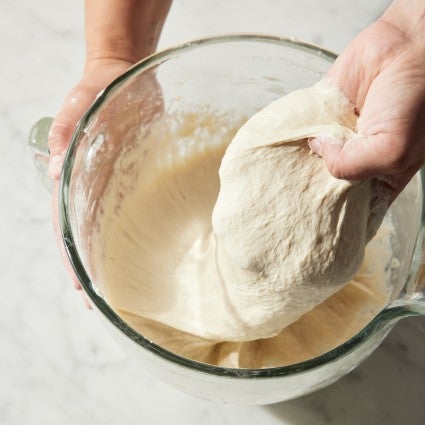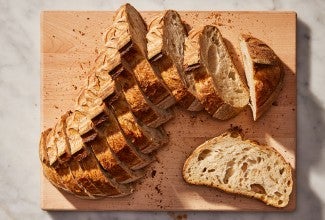


Have you ever wondered about the difference between all-purpose flour and bread flour? Or maybe you’ve noticed the big number on the front of King Arthur flour bags (11.7%, in the case of all-purpose flour) and been curious about what, exactly, it refers to. The answer to both questions is the same: protein percentage, one of the most important variables in flour. But what exactly does that mean, and why does it matter?
Please note: The protein percentages listed for certain types of flour in this post are what we here at King Arthur guarantee. Other brands often have a more variable protein percentage, so results may differ.
When we’re talking about protein in flour, we’re talking about two very specific types of protein found in wheat: glutenin and gliadin.
Crucially, these two proteins are the building blocks of gluten. When water (or a liquid including water, like milk) is added to these two proteins, they link together, forming gluten. Gliadin gives the dough extensibility (which means the dough can be stretched), while glutenin contributes elasticity (so it can snap back like a rubber band).
Ultimately, if the proteins in flour form gluten, then the more protein in the flour — i.e., the higher its protein content — the more gluten-forming potential that flour has. Another way to think about it: the higher the protein content, the “stronger” the flour.

Let’s cover a brief summary of gluten’s role in baking. When liquid is added to glutenin and gliadin, they start forming bonds that link together, developing strands of gluten.
As you mix and knead batters and doughs, you encourage the gluten to develop further. That’s because this movement and agitation encourages the gluten strands to link up and form a network, making them even stronger.
This glutinous web is capable of trapping gas bubbles; the stronger it is, the more gas it can hold, leading to more air in a baked good and thus a higher rise. At the same time, those interconnected strands become longer and stronger the more the gluten develops, which leads to more chewiness and toughness in the final product.
This can be good: You want a strong gluten network in bread dough to capture the gases produced during fermentation. It can also be bad: You don’t want a chewy, stretchy gluten network when making a soft, tender cake.
That’s why the amount of gluten-forming potential in your flour, and thus its protein percentage, matters.
Let’s review three primary types of flour and how their protein content corresponds to their intended use for baking.
Cake flour: With a protein percentage of 10%, this is considered a low-protein flour. It has less gluten-forming potential; when you mix batter made with cake flour rather than all-purpose, less protein is present, and as a result, the batter will likely develop less gluten, resulting in more tender baked goods.
Bread flour: With a protein percentage of 12.7%, this is considered a high-protein flour. It has more gluten-forming potential; when you mix dough made with bread flour rather than all-purpose, more protein is present, and as a result, the dough will likely develop more gluten.
All-purpose flour: With a protein percentage of 11.7%, this flour sits comfortably in the middle — enough protein to develop gluten in bread dough, but not so much that it can’t also be used to make tender cakes, scones, biscuits, and more.
There are plenty of other flours, all with different protein percentages suited to specific types of baking. There’s high-gluten flour, for instance, with a whopping 14.2% protein content that makes it well suited to artisan breads or bagels; on the opposite end of the spectrum, pastry flour has only 8% protein content, so it’s great for bakes like biscuits, scones, and pie crusts.

And finally, a note on whole wheat flours. The total protein content of whole wheat flour is 13.2%, so you might think that, because of its high protein percentage, it would automatically be great for making bread. And it is, but with some caveats.
Because whole wheat flour contains all parts of the wheat berry, including the bran and the germ, the gluten structure is affected. That’s because bran has sharp edges when ground, which cut some of the gluten strands and interferes with their structure. So bread recipes (and other baked goods) with whole wheat flour typically call for specific steps to get around this: They’ll include a long rest time to allow the wheat bran to soften, or call for a second type of flour to get the flavor and nutrition of whole wheat flour but the gluten benefits of another flour.

Unfortunately, some flour brands allow wide fluctuations in their protein content, so every time you use a new bag of flour, you’ll get slightly different results. King Arthur flour, however, is milled with the strictest specifications in the industry. We guarantee that the protein percentage that’s printed on the front of the bag will always match the flour inside of it.
Baking with flour that has a uniform protein content will give you the best, most consistent results at home, so there’s no wasted time or ingredients — just lots of delicious baked goods.
Cover photo by Danielle Sykes; food styling by Liz Neily.



January 28, 2025 at 11:56am
Which flour would be best for using when making Sausage Gravy? (not the biscuits, but the gravy which calls for "all purpose flour" ?
March 15, 2025 at 10:25am
In reply to Which flour would be best… by John (not verified)
Hi John, for gravy you don't really need a high-protein flour, like Bread Flour, so I would go with our Unbleached All-Purpose Flour.
January 13, 2025 at 5:57pm
I've recently begun baking bread and am using your bread flour. My wife has insisted on buying "diet" wheat bread for a long time. Can you enter the conversation (beyond the fact that "diet" bread is cut into thinner slices!) and point me to making a bread she might consider equivalent to her "diet" bread?
March 4, 2025 at 12:23pm
In reply to I've recently begun baking… by BobF (not verified)
If she is looking for lower calorie bread then you could look for recipes that don't have any sugar, butter, or eggs in it, and instead are just simply: water, flour, salt and yeast. On the other hand if she is looking for a low carb bread then adding extra fiber to the recipe could reduce the net carbs quite a bit. You can find nutritional information on most of our recipes just under the ingredient list, to the left of the step by step instructions. Hope you find something that works for you both Bob!
December 6, 2024 at 1:17am
How do you convert 4 gr. protein on your bread flour to 12.7% Protein content? Thank You.
January 8, 2025 at 1:17pm
In reply to How do you convert 4 gr… by S. Apple (not verified)
great question, S! The 4 grams of protein listed on the label of King Arthur's Bread Flour is based on a serving size of 30 grams, as required by the FDA. To convert this to the protein percentage, you divide the protein content (4 grams) by the serving size (30 grams) and then multiply by 100 to get the percentage:
(4 ÷ 30) × 100 = 13.33%
However, this value is rounded for labeling purposes. The actual protein percentage of King Arthur's Bread Flour is 12.7%. This discrepancy happens because the FDA allows rounding on nutritional labels, so both 3.81 grams (12.7%) and 4 grams (13.33%) can appear as "4 grams" on the label.
November 20, 2024 at 11:40am
Can gluten be added to KA unbleached all purpose flour to increase the protein in the flour
November 30, 2024 at 5:07pm
In reply to Can gluten be added to KA… by Barb (not verified)
Hi Barb, yes, the formula for increasing the protein percentage with Vital Wheat Gluten is: adding 1% VWG (as compared to the weight of the flour in your recipe) will increase the protein percentage by .06%. So, say you wanted to increase your Unbleached All-Purpose flour (11.7%) to something closer to the protein percentage of our Bread flour (12.7%), you need an increase of 1%. In this case I would add 2% VWG to increase the protein by 1.2%. Say your recipe had 600g of flour, this would look like: 600 X .02 = 12g of VWG to make the protein percentage approximately equal to 12.9%. Note that flour that has been adjusted for protein content with VWG won't perform exactly like a higher protein flour, and you may need to adjust the hydration of your recipe a bit, since VWG absorbs a fair amount of liquid.
May 27, 2024 at 9:08am
My question is about KA Whole Wheat Flour protein content. I recently replaced an older 5 lb. bag of KA Whole Wheat Flour (dated from 2022) with a new one. The older bag stated 13.8% "Gluten Forming Protein Content" while the newer one states 13.2% protein content. Meanwhile your webpage "How do you choose the right flour?" says that KA Whole Wheat Flour is 14.0% protein, and also that KA prides themselves in consistently delivering the same protein content in their various flour types. If so, how do you explain the variation in these numbers? Thanks for explaining!
May 29, 2024 at 5:10pm
In reply to My question is about KA… by Robert W Davis (not verified)
We completely understand your concern, Robert! Depending on the wheat crop each season, the protein content can vary slightly. Because we want to be as transparent as possible, we print the slight variations in percentage on the flour bags that come from each harvest of wheat. Hope this helps clarify!
Pagination